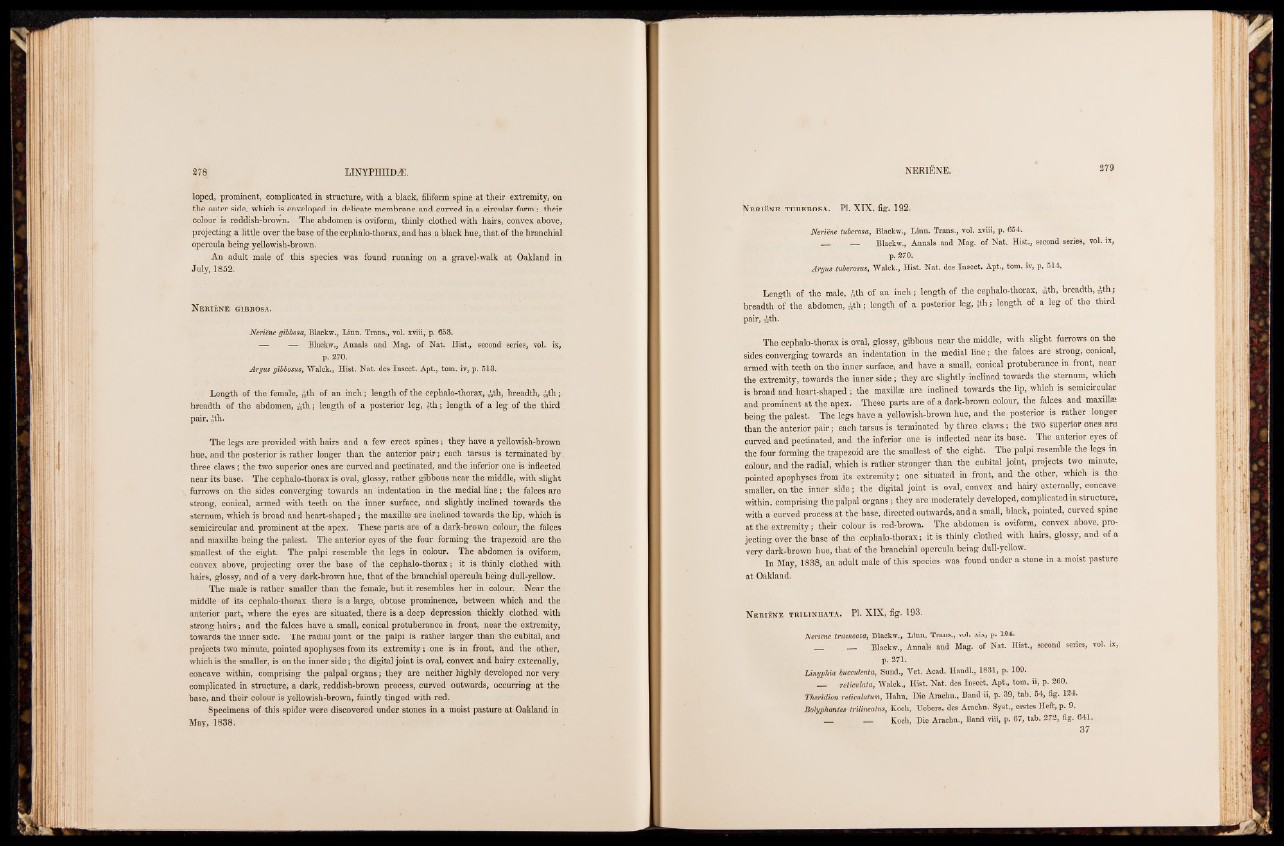
loped, prominent, complicated in structure, with a black, filiform, spine at their extremity, on
the outer side, which is enveloped in delicate membrane and curved in a circular form; their
colour is reddish-brown. The abdomen is oviform, thinly clothed with hairs, convex above,
projecting a little over the base of the cephalo-thorax, and has a.black hue, that of the branchial
opercula being yellowish-brown.
An adult male of this species was found running on a gravel-walk at Oakland in
July, 1852.
Neriene gibbosa.
Neriene gibbosa, Blackw., Linn. Trans., vol. xviii, p. 653.
— — Blackw., Annals and Mag. of Nat. Hist., second series, vol. is,
p. 270.
Argus gibbosus, Walck., Hist. Nat. des Insect. Apt., tom. iv, p. 513.
Length of the female, ^th of an inch; length of the cephalo-thorax, ^th, breadth, ^th;
breadth of the abdomen, ^th; length of a posterior leg, Jth; length of a leg of the third
pair, gth.
The legs are provided with hairs and a few erect spines; they have a yellowish-brown
hue, and the posterior is rather longer than the anterior pair; each tarsus is terminated by
three claws; the two superior ones are curved and pectinated, and the inferior one is inflected
near its base. The cephalo-thorax is oval, glossy, rather gibbous near the middle, with slight
furrows on the sides converging towards an indentation in the medial line; the falces are
strong, conical, armed with teeth on the inner surface, and slightly inclined towards the
sternum, which is broad and heart-shaped; the maxillae are inclined towards the lip, which is
semicircular and prominent at the apex. These parts are of a dark-brown colour, the falces
and maxillae being the palest. The anterior eyes of the four forming the trapezoid are the
smallest of the eight. The palpi resemble the legs in colour. The abdomen is oviform,
convex above, projecting over the base of the cephalo-thorax; it is thinly clothed with
hairs, glossy, and of a very dark-brown hue, that of the branchial opercula being dull-yellow.
The male is rather smaller than the female, but it resembles her in colour. Near the
middle of its cephalo-thorax there is a large, obtuse prominence, between which and the
anterior part, where the eyes are situated, there is a deep depression thickly clothed with
strong hairs; and the falces have a small, conical protuberance in front, near the extremity,
towards the inner side. The radial joint of the palpi is rather larger than the cubital, and
projects two minute, pointed apophyses from its extremity; one is in front, and the other,
which is the smaller, is on the inner sid e; the digital joint is oval, convex and hairy externally,
concave within, comprising the palpal organs; they are neither highly developed nor very
complicated in structure, a dark, reddish-brown process, curved outwards, occurring at the
base, and their colour is yellowish-brown, faintly tinged with red.
Specimens of this spider were discovered under stones in a moist pasture at Oakland in
May, 1838.
Neriene tuberosa. PI. XIX, fig. 192.
Neriene tuberosa, Blackw., Linn. Trans., vol. xviii, p. 654.
__ , __ Blackw., Annals and Mag. of Nat. Hist., second series, vol. ix,
p. 270.
Argus tuberosus, Walck., Hist. Nat. des Insect. Apt., tom. iv, p. 514.
Length of the male, Ath o f an inch; length of the cephalo-thorax, A * , breadth, A * s
breadth of the abdomen, A,* ; length of a posterior leg, Jth; length of a leg of the third
pair, ^th.
The cephalo-thorax is oval, glossy, gibbous near the middle, with slight furrows on the
sides converging towards an indentation in the medial lin e ; the falces are strong, conical,
armed with teeth on the inner surface, and have a small, conical protuberance in front, near
the extremity, towards the inner side ; they are slightly inclined towards the sternum, which
is broad and heart-shaped ; the maxillae are inclined towards the lip, which is semicircular
and prominent at the apex. These parts are of a dark-brown colour, the falces and maxillae
being the palest. The legs have a yellowish-brown hue, and the posterior is rather longer
than the anterior pair; each tarsus is terminated by three claws; the two superior ones are
curved and pectinated, and the inferior one is inflected near its base. The anterior eyes of
the four forming the trapezoid are the smallest of the eight. The palpi resemble the legs in
colour, and the radial, which is rather stronger than the cubital joint, projects two minute,
pointed apophyses from its extremity; one situated in front, and the other, which is the
smaller, on the inner sid e ; the digital joint is oval, convex and hairy externally, concave
within, comprising the palpal organs; they are moderately developed, complicated in structure,
with a curved process at the base, directed outwards, and a small, black, pointed, curved spine
at the extremity; their colour is red-brown. The abdomen is oviform, convex above, projecting
over the base of the cephalo-thorax; it is thinly clothed with hairs, glossy, and of a
very dark-brown hue, that of the branchial opercula being dull-yellow.
In May, 1838, an adult male of this species was found under a stone in a moist pasture
at Oakland.
Neriene trilineata. PI. XIX, fig. 193.
Neriene trilineata, Blackw., Linn. Trans., vol. xix, p. 124.
__ __ Blackw., Annals and Mag. of Nat. Hist., second series, vol. ix,
p. 271.
Linyphia bucculenta, Sund., Vet. Acad. Handl., 1831, p. 109.
__ reticulata, Walck., Hist. Nat. des Insect. Apt., tom. ii, p. 260.
Theridion reticulatum, Hahn, Die Arachn., Band ii, p. 39, tab. 54, fig. 124.
Bolyphantes trilineatus, Koch, Uebers. des Arachn. Syst., erstes Heft, p. 9.
__ __ Koch, Die Arachn., Band viii, p. 67, tab. 272, fig. 641.
37